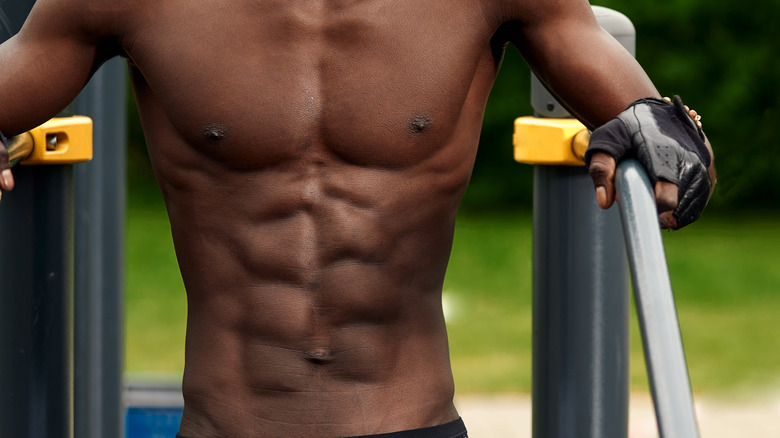Why You May Have Asymmetrical Abs
If you've been striving for picture-perfect abs to post on social media, the reality is that much like many other internet aspirations, the perfect six-pack abs may not be obtainable for most people. In fact, after dedicating time to the right balance of exercise and diet, many people attain four-pack abs, while others may even see eight and 10-pack abs (via Healthline). Furthermore, some people end up with asymmetrical abs.
First things first, you shouldn't be self-conscious if you don't have a perfectly symmetrical six-pack. According to Men's Health, asymmetrical abs are more common than you'd probably think, and many athletes have staggered abs. A lot of competitive bodybuilders have uneven abs, and many have four-packs instead of six-pack abs. So if some of the most muscular and fit athletes in the world have abs that don't meet the social media ideal and they're boldly showing off their bodies, you shouldn't have any reason to be self-conscious, either! Here are some reasons why you may have asymmetrical abs.
The appearance of abs is genetic
In general, the appearance of your abs is due to genetics. There are three major components to abs, which are the rectus abdominis, the linea alba, and muscular bands called tendinous intersections (via Healthline). The rectus abdominis is the main muscle that comprises the abdominal muscles, the linea alba runs vertically down the middle of the rectus abdominis to create the division of left and right abs, and the tendinous intersections run horizontally across the rectus abdominis to create individual expressions of abs. People are born with different numbers of tendinous intersections, which determine the number of abs you can achieve in the gym.
Asymmetrical abs can be genetic, reports Men's Health. Called staggered abs, an uneven appearance occurs when the tendinous intersections don't quite line up. While the rectus abdominis is equally distributed on both sides by the linea alba, it's the tendinous intersections that run horizontally that create the appearance of asymmetrical abs when they don't run in perfectly straight lines across your abdomen. Additionally, genetics can affect the distribution of body fat. If you happen to have unequal distributions of fat deposits in your abdomen, the result may be the appearance of uneven abs which you might be able to remedy with training (per Healthline).
Medical conditions can cause uneven abs
Healthline describes several conditions that might lead to the appearance of asymmetrical abs, including conditions related to muscle development and spinal structure. Scoliosis is a condition that occurs when the spine develops abnormal curvature. Correlating abdominal muscles might become uneven if the muscles in the back develop unevenly.
Asymmetrical abs can also result from damage to the musculature structure of the back, notes Healthline. Another possible culprit is imbalanced exercise training. When you are in the gym, be certain to do the same number of reps of each exercise for both sides of your body. Otherwise, the result could be muscles on one side becoming larger and thus asymmetrical. This means that you shouldn't slack on one side of side planks or oblique crunches, especially if you feel like one side is weaker than the other. It's also important to emphasize ab exercises since a strong core can protect your back from injury.



